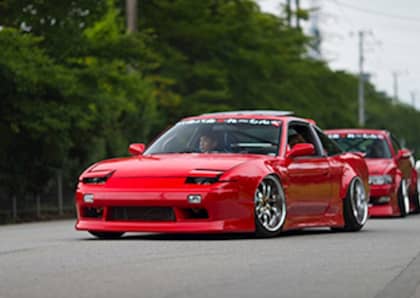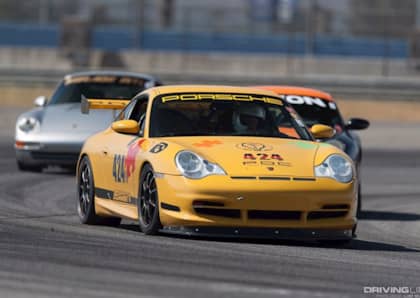The Check Shop: Porsche 997 GT3
In Japan, even amateur racing is serious business. If you're familiar with the Idlers Club, Japan's most famous racing club for grassroots racing, then you must have heard about The Check Shop and the stable of cars they bring. Best known for their track-prepped Porsches, it was a bit of a surprise coming across one of them equipped with a roof carrier at Tokyo Auto Salon 2017. This Porsche 997 GT3 definitely qualifies as an exotic with a nice rack, and after further inspection, we knew it had to have its own feature.

Check Out the Rack on That One
This bright yellow Porsche belongs to none other than Naohiko Otsuka, CEO of The Check Shop. This car not only servers as his personal car, but he also uses it as a platform for research and development. When we asked how he felt about his car having a roof carrier in the VDL Hapro booth, he gave us a little chuckle and told us he thought it was pretty interesting.
The car never goes skiing or camping; it only goes to the track. Coupled with its interior and wide racing wheels and tires, it was definitely a head scratcher. We understood what was trying to be conveyed; VDL Hapro has a storage solution for any car, even one as crazy as Mr. Otsuka's Porsche 997 GT3 RS.

Checking In at The Check Shop
Japan is known for its limited space, so you can understand our surprise as we arrived to find a rather expansive facility that includes both a service center and warehouse. The next surprise, or surprises, were found inside the service center. Expecting a majority of Porsches, we found ourselves a mix of supercars, including Lamborghinis and Ferraris.

Mr. Otsuka has been modifying cars professionally for about 20 years, and this has been at his current location for about seven. Around the same time that he opened his current shop, he started working on Porsches for customers, helping to fulfill his childhood dreams. Since he was a child, Mr. Otsuka has always been a fan of Porsches, specifically the 935 and 934, and the GTP models 956 and 962. As he told us, he just likes race cars; therefore, he likes Porsches.

Those childhood dreams were the driving force to get involved in Porsches, but it was another moment that really ignited his competitive racing side. As if it happened yesterday, Mr. Otsuka told us about the team that beat him at Fuji Speedway — a GT300 driver in a GT3 RS. And just like that, that loss is what sparked his need to become faster and not lose in that same situation again. As fate would have it, about five years ago, a friend of Mr. Otsuka was selling a 2007 997 GT3, and it was exactly what he was looking for to build a GT300-beater. Next step, draw up the plans.

Step-by-Step
Mr. Otsuka could have chosen to simply add all the go-fast parts at once and hit the track, but instead, he chose to modify step-by-step in order to learn how each modification affected the performance of the car. First, the suspension was upgraded by replacing the stock struts and springs for a set of JRZ 12 31 triple adjustable coilovers with external reservoir.
Additionally, the uprights, lower control arms and subframe were replaced with those from a 2010 997 cup car. The bushings and dogbones were replaced with RSS pieces while an adjustable Tarett Engineering bladed sway bar was installed. Not your average sway bar, the Tarett Engineering bar is adjustable from the interior of the car, allowing it to be fine tuned even while driving.

The corners are equipped with very wide Agio Competizione NMF wheels; the fronts are 18 by 9.5 inches, and the rear are 18 by 13 inches.
Power Ups
Although not the most powerful of the 997 engines available, the 3.6 liter definitely holds its own. With 409 horsepower and 295 ft-lb of torque at 4600 rpm straight from the factory, most would be content, but not Mr. Otsuka. Opting out of a simple engine swap, the 3.6 was sleeved to 4.0 liters and fitted with 997 3.8-liter pistons and RSR crankshafts.
To make sure everything stayed lubricated properly, an RSR oil pump was added. Of course, the ECU was upgraded along with 997 cup engine mounts. All the heat escapes through a pair of Volcano exhaust manifolds merging into a Volcano silencer. There is also a straight exhaust version which is used on the circuit only. We are sure Mr. Otsuka's neighbors are grateful for the consideration, because even with the silencer, we could hear the exhaust note echoing off the nearby buildings.

In Control
Power is sent to the ground from a stock transmission with stock first and second gears. Gears three through six have been upgraded to suit Mr. Otsuka's driving preferences at Fuji Speedway.
To get the torque to the transmission is an Ogura Racing Clutch that Mr. Otsuka describes as "light, but so good!" Rounding off the drivetrain components, the differential has been rebuilt with the same plates as those used by the 997 cup cars.

Of course if one wants to go faster, one also has to be able to stop. That lead to the addition of a StopTech Trophy brake kit along with StopTech SR34 brake pads. According to Mr. Otsuka, he can start braking at the 150-meter mark at the end of the main straight at Fuji Speedway.
Looks Fit To Kill
Although Mr. Otsuka is focused on reducing his lap times, he also wants his 997 to look the part. This being a U.S. model 997 GT3 meant that it was equipped with a factory sunroof that Mr. Otsuka wasn't too keen on. He could have opted for a carbon fiber roof, but instead chose to go with original steel due to rigidity concerns.
The first generation's bumpers were another aspect he wasn't a fan of and chose to swap both the front and rear from a second generation GT3. In addition, he swapped the fenders to go with a turbo wide body, including custom vented fiberglass fronts to provide additional downforce.

You can't mention downforce without talking about the GT spoiler on the rear. Featuring a Kohlenstoff cup-style wing with custom stands, it is perched on a Kohlenstoff custom hood.

To help keep the weight down, the interior was gutted and the doors replaced with fiberglass ones. Additionally, the door glass and rear side glass was replaced with polycarbonate to ensure maximum weight reduction.
Inside the Cockpit
With the interior gutted it was prepared for the circuit with the addition of safety equipment including an RSS roll cage, Cobra dry carbon seat, and Simpson racing harnesses. A Renown steering wheel and Numeric Racing shifter complete the interior list. If you were wondering what the levers by the shifter are, those are the adjusters for the sway bars.

Numbers Don't Lie
Although the latest setup has not been dyno tested, the on-track improvements are what matter to Mr. Otsuka. With a now estimated 443 horsepower, his lap times at Fuji have fallen from 1:51 to 1:49 with an improved top speed from 264 km/h to 270 km/h. That is equivalent to a 997 cup car.
Still looking to shave another 2 seconds off, he has thought about installing a sequential transmission, but is a bit hesitant. Believe it or not, the Porsche is still street legal; installing a sequential would make it a bit more difficult to drive on the local roads.

Holding the fastest times for an air- or liquid-cooled, naturally aspirated Porsche at Twin Ring Motegi and Tsukuba, his favorite circuit remains for him to conquer. We know it will be challenge to cut another 2 seconds off and become the fastest at Fuji Speedway, but we are confident he will be able to do both.
Stay up to date with Mr. Otsuka's progress on @checkshopinc, and get exclusive in-car footage from The Check Shop's YouTube channel.











